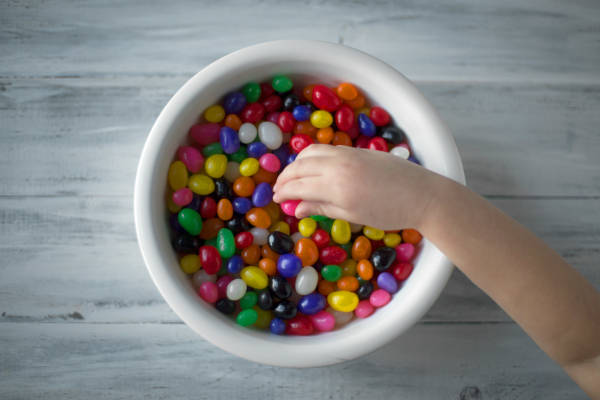This month for the Early Bloom Podcast we were joined by Louise Mercieca, award-winning nutritional therapist and founder of The Health Kick.
She’s dedicated to improving early years and nursery nutrition through education, so we thought we’d take a look together at debunking some nursery nutrition myths you might have heard of.

Nutrition myth: It's only about the menu
The government has a requirement that every setting provide ‘healthy, balanced and nutritious’ meals for its children. In England, this includes some dry documentation on example menus, with exciting notes such as ‘Limit canned pasta in sauce’.
If you follow your given government’s rules, your setting has fulfilled its nutritional obligation.
Nutrition reality: It's about knowing the ingredients
The four food groups given in the above documentation are:
- Starchy foods
- Fruit and veg
- Pulses, beans, fish, eggs, meat and other proteins
- Dairy and alternatives
While these are useful, if you treated each group equally your menu would be very unbalanced, and you’ve got to seek a separate guide to find any sort of ratio for one against the other. Even then, the best we’ve seen is 33% starch and 33% fruit and veg, but you’re on your own for the rest.
And while starchy food covers potatoes, bread, rice and pasta, the more processed a starchy food is, the less a developing stomach is prepared to break it down. They’re equally filling, but not equally nutritious.
What it all comes down to, is knowing your nutrition, which will set you apart from your local competitors. Just putting spag bol on the menu isn’t enough – you need to make sure you’re getting the right balance of proteins, amino acids, vitamins, minerals, fat (the right kinds) and more for those developing brains and bodies.
“Use this nutritional knowledge to enhance CPD, linking early food intake to every stage of early childhood development: from building a brain with Essential Fatty Acids to using a weaning menu to support speech and language development.”
Louise Mercieca
Nutrition myth: Food is a treat
Rewarding good behaviour with a favourite food, dessert after every meal, special meals after a hard day. We’ve all been there, buying ourselves a takeaway after a long week, and it’s an easy way to win little hearts and minds by saying ‘if you’re good you can have toast and jam – it’s your favourite!’.

It’s not all the time, so what’s the harm?
Nutrition reality: Food treats build bad habits
Our lifelong relationship with food begins in the early years, and that includes food-as-reward. While TV and films certainly feeds into the takeaway-as-treat mentality (and ads we say don’t influence us), but would we even think to treat ourselves with food if we hadn’t been treated as children?
“Food is not a treat, reward or bribe. It is fuel, it is nourishment, it is simply food. It shouldn’t comfort, won’t solve emotional issues, and can lead adults to have distorted feelings of whether they ‘deserve’ food.”
Louise Mercieca
Food performs a function in our daily lives – keeping us alive. While chocolate and jam doesn’t, each meal is a straightforward refuelling exercise, and we need to teach this to children so they know what meals are really for. They’ll always have a favourite, but if it’s nutritionally unstable it shouldn’t be offered as any kind of reward.
If a child’s being difficult, don’t offer sweets or food treats to bring them out of it. Go to a toy or book before anything to do with food. In the words of Louise Mercieca on our latest podcast, ‘Food’s been placed on a pedestal it doesn’t deserve to be on’. And it’s in early years education where we can start to take it down a peg.
Nutrition myth: Food energy is mainly for movement
Exercise burns calories, calories are in food, therefore food is for exercise. It certainly makes sense to a degree – you feel energised with a coffee or burst of electrolytes. So surely kids are also burning off their finger food calories by running around the nursery?

Nutrition reality: Nutrition fuels everything
Every nursery worker’s seen it, parents are flabbergasted by it – children’s brains develop at a pace that outstrips any learning you might do later in life. And that development, those growing active brains, are fuelled by food. Up to 50% of it in fact, while for adults it’s more like 20-25%.
In this case though, it’s not a pure ‘calories = brain development’ trade, though they do get used there. As with the ‘knowing your ingredients’ point above, children (and adults) can only build the right vital brain connections if they’re getting the proteins and amino acids that allow for the building along with calorie energy.
Ever wondered why nutrition guides suggest oily fish a lot of the time? Amino acids, essential fatty acids (EFAs) and brain development is why. We’re not going to go into all of their technical names here, but you can find those essential amino acids (meaning the body can’t make them) in eggs, mushrooms, fish, legumes and beans, and food-of-the-now quinoa.
Vegan diets in particular need special attention to ensure lysine, methionine and tryptophan are included. Some plant-based proteins like quinoa (mentioned above), soy, and buckwheat contain these essentials.
As for essential fatty acids, they make up 40% of our brains and are another chemical the body can’t make (that’s why they’re ‘essential’). Not just found in eggs and fish, but also in fruit and veg rich in vitamin C, particularly berries.
Know your nutrients!
Nutrition myth: Don't play with your food
We all heard it as kids, and if you didn’t you probably learned there was no harm in it. But either way, it’s a mantra for reducing mess and focusing on why the food is in front of them – to be eaten. To play with your food is to insult the chef, learn bad manners and waste precious nutrients to the floor.

Nutrition reality: Some kids need to play
For some children, this ‘playing’ method of eating is the only way they know or will accept how – those that are neurodivergent or otherwise fixed into a particular eating routine. To force them not to ‘play with their food’ would increase their levels of stress – and stressed children don’t eat.
“If suitable sensory awareness of food required for a child to feel safe and secure, this should be encouraged, not discouraged”
Louise Mercieca
Similarly, one of the areas babies need to develop as they grow is fine motor skills, often first signified by their ability to pick up a grain of rice. Sounds suspiciously like playing with their food, right?
And this continues throughout the early years, with learning how to use cutlery, eat vegetable puffs, leading to learning how to write with a pencil. It all starts with food!
Nutrition myth: If there’s a food intolerance, it must be removed
It sometimes feels like the level of food intolerances is growing, and the increasing size of free-from aisles serves to prove it. Parents are seeing increased irritability when their children eat certain foods, so the simplest solution for a nursery is just to cut that food out of the child’s, or even the whole setting’s, menu.
Nutrition reality: Some intolerances are misdiagnosed, or never diagnosed at all
It is extremely hard to pin down a single ingredient’s cause for an upset stomach if it doesn’t cause a rash (allergy) or otherwise outwardly-obvious effect. It can take 4 weeks of an elimination diet to pinpoint a cause for a gastrointestinal problem.
There’s also limited scientific literature proving non-coeliac gluten intolerance (for example) exists. So can we be sure the parent has identified it correctly? Is there a medical note to support it?
This isn’t to suggest going against identified or suspected allergies, or genuine intolerances. Allergies are extremely serious medical conditions, and all staff should be trained in how to recognise and deal with them quickly and effectively.
Be certain it’s a true intolerance (they cannot digest it), and not simply secretly a child’s preference, before removing an ingredient from a child’s diet. If you do make the decision to remove, we refer you back to myth one – know your nutrition so you can replace the missing nutrients with ease.
“If it is a genuine intolerance or there is a catalogue of evidence to show a pattern with the food then it can be removed, but removing too many foods can be detrimental to a child's overall immunity against intolerances – the more restricted their intake, the more likely for increased intolerances.”
Louise Mercieca
Nutrition myth: Different meals only for special occasions
On those culturally mandated ingredients, it’s good to share culture at different times of the year. Special meals during Eid, Easter, Chinese New Year, Passover, Thanksgiving and more can teach children about the rest of the world.
As they can sometimes require ‘special’ ingredients, it’s simplest only to cook them when a particular event requires it.
Nutrition reality: This can make certain cuisines, and children, feel ‘other’
Partially covered in the EYFS ‘fundamental British values’, Britain is increasingly multicultural, and this means there are kids in your nursery that have already grown up with food that might be seen as ‘different’ by other children.
If they come to nursery and that food is nowhere in sight, they might start to think their food isn’t ‘normal’.
Add in that suddenly their food is only available at one time of year, other children might think that that food should only be eaten at that time of year, feeding into the ‘othering’ of that cuisine.
"Habitually embrace different cultures not just to meet a #day or a celebration event as this can make children feel singled out.”
Louise Mercieca
You can still do something special on special events, as the dishes might be different on those days than they are normally (Americans don’t eat turkey every day for example). Just don’t only do international dishes then.
Try to incorporate other cuisines into your rotating menu, without putting too much pressure on your likely singular chef, so children can explore multicultural flavours throughout the year.
For more nutritional insights from Louise Mercieca, check out the Early Bloom Podcast or visit The Health Kick!